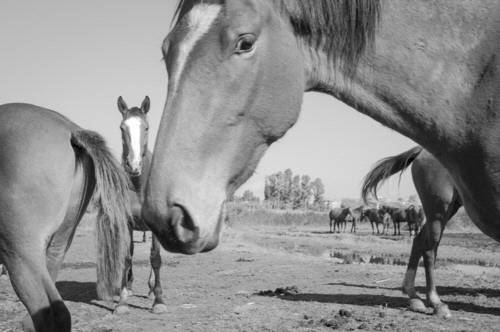We met Anna Maria at her guest house Is Procilis in Palmas Arborea, a small village of about 1000 inhabitants. Just after we had met, she seemed very intent on maintaining traditions pertaining to food. Besides, the guest house had been furnished very tastefully.
Having entered the dining room of the guest house, a bundle of Cappelli wheat, lying on a large wooden board, caught our attention. Anna Maria told us that this type of grain was developed in the 1910s and called Cappelli because of the aid Senator Cappelli gave to research and development of this grain. After some time when it was in little use, it is being revalued particularly in Sardinia, and Anna Maria wants to cultivate it organically in order to use it in bread-making.
There was also an artistically shaped bread, called su coccoi, lying on the wooden board. This bread was and is used as a decoration during Easter and as a gift for making good wishes at weddings, baptisms and other ceremonies. It is made from semolina, durum wheat, water, salt and a sourdough starter.
The distinctive trait of this bread, in addition to the type of flour with which it is baked in a traditional way, is the use of a sourdough starter. According to Anna Maria, the yeasts in the sourdough starter have some particular enzymes (large biological molecules responsible for the thousands of metabolic processes that sustain life) which require a long time of leavening in order to metabolise (the sum of the physical and chemical processes in an organism by which its material substance is produced, maintained, and destroyed, and by which energy is made available) the gluten (a protein composite found in foods processed from wheat and related grain species. Gluten gives elasticity to dough, helping it rise and keep its shape and often gives the final product a chewy texture) resulting in a very digestible and wholesome bread.
Anna Maria also uses sourdough starters for preparing other types of Sardinian bread like is prezzidas, is follittasa, sa carrogheddas, etc. All of them are prepared using semolina derived from durum wheat, water, salt and wild yeast, but they have different softness and shelf life because of different baking and different quantities of ingredients used. Anyway, making these breads require several days: sourdough starter has to be prepared, preparing and kneading the dough, waiting for the leavening whose duration depends on the weather and the season and finally baking the breads.
Anna Maria wants very much to maintain and bring back old traditions, in particular everything regarding food, she’s very conscious of what food she serves at her guest house offering her guests old Sardinian dishes like soups, sauces prepared from wild boar and hare, homemade bread, etc.
Moreover, Sardinian cows, pigs, ducks, chickens and rabbits are raised at the farm of Is Procilis, which is using the meats for preparing sausages and preparing dishes like barbecued piglet (maialetto allo spiedo) and cordula di agnello, a dish based on lamb. They are also growing cereals for the animals, durum wheat for making bread, pasta and sweets. Wine is made at the farm, while products which are not made at the farm are bought from local producers.
The other grand passion of Anna Maria is breeding horses of the race Anglo-Arab-Sardinian for show jumping. After having visited the guest house, we walked with Anna Maria to a group of horses living outside all year in a place just outside the village. Walking along a narrow canal, we met two horses, mother and daughter. Proceeding, we met a group of horses of various colours, all of which Anna Maria recognised and calling everyone by name.
While there, Anna Maria explained that when the foals are two years old, they start training very carefully with the rider on the ground because the dorsal spine and the cartilage ares still quite fragile.
The training consists of examining the morphology (aspects of the outward appearance like shape, structure, colour and pattern as well as the form and structure of the internal parts like bones and organs) of the horse and how it is walking when being presented by its trainer, show jumping and dressage (horse and rider are expected to perform from memory a series of predetermined movements). Gradually, the horses will be evaluated on a regional level and when the horses reach four years, they start competing by show jumping (starting with obstacles of 80 cm and doing 90 cm height when the horses are adults) as time progresses, they have to pass more difficult courses.
The visit to Is Procilis was very interesting and we are grateful to Anna Maria for having let us visit an enterprise maintaining alimentary traditions of the region, besides raising horses for competitions.

